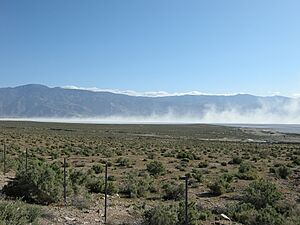Owens Lake facts for kids
Quick facts for kids Owens Lake |
|
|---|---|

Image of the Owens Valley from the International Space Station -- oriented top = true west.
|
|
| Location | Sierra Nevada Inyo County, California, USA |
| Coordinates | 36°26′00″N 117°57′03″W / 36.433269°N 117.950916°W |
| Type | Flat |
| Primary inflows | Owens River Natural springs and wells |
| Basin countries | United States |
| Max. length | 17.5 mi (28.2 km) |
| Max. width | 10 mi (16 km) |
| Max. depth | 3 ft (0.91 m) |
| Surface elevation | 3,556 ft (1,084 m) |
Owens Lake is a mostly dry lake in eastern California. It is located in Inyo County, about 5 miles (8.0 km) south of Lone Pine, California. The lake sits at the base of the Sierra Nevada mountains.
For thousands of years, Owens Lake was a large, shallow body of water. But unlike many other dry lakes, Owens Lake held water until 1924. Today, some water has returned to the lake. This is thanks to efforts to restore part of the Owens River's flow.
Contents
Why Owens Lake Dried Up
Owens Lake used to be fed mainly by the Owens River. This river flowed from the Sierra Nevada mountains into the lake. But in the early 1900s, the city of Los Angeles needed more water.
The Los Angeles Aqueduct
To get water, Los Angeles built a huge system called the Los Angeles Aqueduct. This aqueduct was designed to carry water from the Owens River all the way to Los Angeles. Construction of the aqueduct began in 1908. It was finished in 1913.
Once the aqueduct was built, most of the Owens River's water was diverted. This meant the water no longer flowed into Owens Lake. Without its main water source, the lake began to shrink. By 1924, Owens Lake was almost completely dry.
Dust Storms and Pollution
When Owens Lake dried up, its bed was left exposed. The lakebed contained a lot of salty minerals and fine dust. When strong winds blew across the dry lakebed, they picked up this dust.
These dust storms were a big problem. The dust contained tiny particles that could cause health issues. It also made the air very dirty. This pollution affected people living nearby. It also harmed the environment.
Bringing the Lake Back to Life
People realized that the dust storms from Owens Lake were a serious issue. So, efforts began to control the dust. This involved several projects to cover or wet the lakebed.
Dust Control Methods
One way to stop the dust is to flood parts of the lakebed with shallow water. This keeps the dust from blowing away. Another method is to plant special salt-tolerant plants. These plants help hold the soil in place.
Some areas are covered with gravel. This also prevents the dust from becoming airborne. These projects have greatly reduced the dust storms.
Water Restoration Efforts
Over time, agreements were made to return some water to Owens Lake. This means a portion of the Owens River's flow now reaches the lake again. This helps keep parts of the lakebed wet. It also creates some shallow water habitats.
Today, Owens Lake is still mostly dry. But it is no longer the dusty, polluted place it once was. The efforts to manage the lakebed have made a big difference. They show how people can work to fix environmental problems.
Images for kids
-
Image of the Owens Valley from the International Space Station – oriented top = true west








